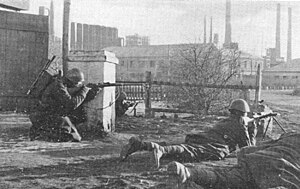
Back المشاركة الإيطالية على الجبهة الشرقية Arabic Participation italienne sur le front de l'Est French Campagna italiana di Russia Italian Włoski udział na froncie wschodnim Polish Итальянские войска в СССР (1941—1943) Russian
| Italian participation on the Eastern Front | |||||||
|---|---|---|---|---|---|---|---|
| Part of the Eastern Front of World War II | |||||||
 Italian troops near Stalino in 1941 | |||||||
| |||||||
| Belligerents | |||||||
|
|
| ||||||
| Commanders and leaders | |||||||
| |||||||
| Strength | |||||||
|
| ||||||
| Casualties and losses | |||||||
| No specific data available on the Red Army's casualties caused by the Italian forces alone | ||||||
The Italian participation on the Eastern Front represented the military intervention of the Kingdom of Italy in the Operation Barbarossa, launched by Nazi Germany against the Soviet Union in 1941. The commitment to actively take part in the German offensive was decided by Benito Mussolini a few months before the beginning of the operation, when he became aware of Adolf Hitler's intention to invade, but it was confirmed only in the morning of 22 June 1941, as soon as the Italian dictator was informed that same day the German armies had invaded the Soviet Union.
An expeditionary force quickly became operational, with three divisions, previously put on alert: called the "Italian Expeditionary Corps in Russia" (Corpo di Spedizione Italiano in Russia, CSIR), it arrived on the eastern front in mid-July 1941. Initially integrated into the 11th German Army and then in the 1st Panzer Army, the CSIR participated in the campaign until April 1942, when the needs of the front required the sending of two other Italian corps which together with the CSIR were reunited into the 8th Italian Army or "Italian Army in Russia" (Armata Italiana in Russia, ARMIR). Deployed to the south, in the Don river sector, the 8th Italian Army together with the 2nd Hungarian Army and the 3rd Romanian Army were assigned to cover the left flank of the German forces that were advancing towards Stalingrad at the time.
Rapid reversals at the front changed the course of the battle; after the encirclement of the German forces in Stalingrad, the subsequent Soviet offensive that began on 16 December 1942 overwhelmed the 2nd and 35th Italian Army Corps (former CSIR), which were part of the southern deployment of the 8th Army, and six Italian divisions together with German and Romanian forces were forced to a hasty retreat. On 13 January 1943, a second major Soviet offensive north of the Don overwhelmed the Alpini troops still in line, poorly equipped and short of supplies, who retreated along the steppes. The retreat cost the Italian forces tens of thousands of men and ended on 31 January, when the 2nd Alpine Division Tridentina reached the first German outposts in Shebekino. The repatriating operations lasted from 6 to 15 March and ended on 24 March, putting an end to the Italian military operations in the Soviet Union.[3]
- ^ Arrigo Petacco (2015). L'armata scomparsa. Mondadori. pp. 20–21, 123. ISBN 978-88-04-59587-8.
- ^ Giorgio Scotoni (2007). L'Armata Rossa e la disfatta italiana (1942-43). Panorama. pp. 260–261. ISBN 978-88-7389-049-2.
- ^ Thomas Schlemmer (2009). Invasori, non vittime - La campagna italiana di Russia 1941-1943. Laterza. p. 289. ISBN 978-88-420-7981-1.